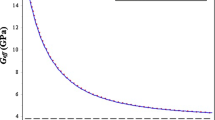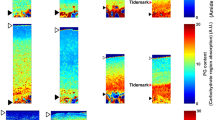Abstract
Mechanical test specimens were prepared from the cranial and caudal cortices of radii from eight horses. These were subjected to destructive tests in either tension or compression. The ultimate stress, elastic modulus and energy absorbed to failure were calculated in either mode of loading. Analysis was performed on the specimens following mechanical testing to determine their density, mineral content, mineral density distribution and histological type. A novel technique was applied to sections from each specimen to quantify the predominant collagen fibre orientation of the bone near the plane of fracture. The collagen map for each bone studied was in agreement with the previously observed pattern of longitudinal orientation in the cranial cortex and more oblique to transverse collagen in the caudal cortex. Bone from the cranial cortex had a significantly higher ultimate tensile stress (UTS) than that from the caudal cortex (160 MPa vs 104 MPa; P<0.001) though this trend was reversed in compression, the caudal cortex becoming relatively stronger (185 MPa vs 217 MPa; P<0.01). Bone from the cranial cortex was significantly suffer than that from the caudal cortex both in tension (22 GPa vs 15 GPa; P<0.001) and compression (19 GPa vs 15 GPa; P<0.01). Of all the histo-compositional variables studied, collagen fibre orientation was most closely correlated with mechanical properties, accounting for 71% of variation in ultimate tensile stress and 58% of variation in the elastic modulus. Mineral density and porosity were the only other variables to show any significant correlation with either UTS or elastic modulus. The variations in mechanical properties around the equine radius, which occur in close association with the different collagen fibre orientations, provide maximal safety factors in terms of ultimate stress, yet contribute to greater bending of the bone as it is loaded during locomotion, and thus lower safety factors through the higher strains this engenders.
Similar content being viewed by others
References
Ascenzi A (1988) The micromechanics versus the macromechanics of cortical bone — a comprehensive presentation. J Biomed Eng 110:357–363
Ascenzi A, Bonucci E (1964) The ultimate tensile strength of single osteons. Acta Anat 44:160–183
Ascenzi A, Bonucci E (1967) The tensile properties of single osteons. Anat Rec 158:375–386
Ascenzi A, Bonucci E (1968) The compressive properties of single osteons. Anat Rec 161:377–392
Ascenzi A, Bonucci E (1972) The shearing properties of single osteons. Anat Rec 172:499–510
Ascenzi A, Bonucci E (1976) Relationship between ultrastructure and “Pin Test” in osteons. Clin Orthop 121:275–294
Bargren JH, Bassett CAL, Gjelsvik A (1974) Mechanical properties of hydrated cortical bone. J Biomech 7:239–245
Bertram JEA, Biewener AA (1988) Bone curvature: sacrificing strength for load predictability? J Theor Biol 131:75–92
Biewener AA, Thomason J, Goodship AE, Lanyon LE (1983a) Bone stress in the horse forelimb during locomotion at different gaits: a comparison of two experimental models. J Biomech 16:565–576
Biewener AA, Thomason J, Lanyon LE (1983b) Mechanics of locomotion and jumping in the forelimb of the horse (Equus): in vivo stress developed in the radius and metacarpus. J Zool 201:67–82
Boyde A, Jones SJ (1983) Back-scattered electron imaging of skeletal tissues. Metab Bone Dis Rel Res 5:145–150
Burstein AH, Currey JD, Frankel VH, Reilly DT (1972) The ultimate properties of bone tissue: the effects of yielding. J Biomech 5:35–44
Cartwright AG (1975) The effect of histological variation on the tensile strength of cortical bone. Biomed Eng 10:442–446
Claussen BF (1982) Chronic hypertrophy of the ulna in the professional rodeo cowboy. Clin Orthop 164:45–47
Currey JD (1959) Differences in the tensile strength of bone of different histological types. J Anat 93:87–95
Currey JD (1975) The effects of strain rate, reconstruction and mineral content on some mechanical properties of bovine bone. J Biomech 8:81–86
Currey JD (1981) What is bone for? Property-function relationships in bone. In: Cowin SC (ed) Mechanical properties of bone. ASME, AMD vol 45, pp 13–26
Currey JD (1984a) The mechanical adaptations of bones. University Press, Princeton
Currey JD (1984b) What should bones be designed to do? Calcif Tissue Int 36:S7-S10
Currey JD (1988) The effect of porosity and mineral content on the Young's Modulus of elasticity of compact bone. J Biomech 21:131–139
Evans FG (1976) Mechanical properties and histology of cortical bone from younger and older men. Anat Rec 185:1–12
Evans FG, Bang S (1967) Differences and relationships between the physical properties and the microscopic structure of human femoral, tibial and fibular cortical bone. Am J Anat 120:79–88
Evans FG, Vincentelli R (1969) Relations of collagen fibre orientation to some mechanical properties of human cortical bone. J Biomech 2:63–71
Evans FG, Vincentelli R (1974) Relations of the compressive properties of human cortical bone to histological structure and calcification. J Biomech 7:1–10
Evans GP, Behiri JC, Vaughan LC, Bonfield W (1992) The response of equine cortical bone to loading at strain rates experienced in vivo by the galloping horse. Equine Vet J 24:125–128
Frost HM (1973) Bone modelling and skeletal modelling errors. Orthopaedic Lectures 4. Thomas, Springfield, Ill, USA
Gebhardt W (1905) Über functionelle wichtige Anordnungsweisen der feineren und gröberen Bauelemente des Wirbeltierknochens. II. Spezieller Teil. I. Der Bau der Havers'schen Lamellensysteme und seine funktionelle Bedeutung. Arch Entwicklungsmech Org 20:187–322
Goodship AE, Lanyon LE, Mcfie H (1979) Functional adaptation of bone to increased stress. An experimental study. J Bone Joint Surg 61-A:539–546
Gordon KR, Perl M, Levy C (1989) Structural alterations and breaking strength of mouse femora exposed to three activity regimens. Bone 10:303–312
Jaworski ZFG, Liskova-Kiar M, Uhthoff HK (1980) Effect of long term immobilization on the pattern of bone loss in older dogs. J Bone Joint Surg 62-B: 104–110
Jones HH, Priest JD, Hayes WC, Tichenor CC, Nagel DA (1977) Humeral hypertrophy in response to exercise. J Bone Joint Surg 59-A:204–208
Jowsey J, Kelley PJ, Riggs BL, Bianco AJ, Scholz DA, GershonCohen J (1965) Quantitative microradiographic studies of normal and osteoporotic bone. J Bone Joint Surg 47-A:785–806
Lanyon LE (1980) The influence of function on the development of bone curvature. An experimental study on the rat tibia. J Zool 192:457–466
Lanyon LE (1987) Functional strain in bone tissue as an objective, and controlling stimulus for adaptive bone remodelling. J Biomech 20:1083–1093
Lanyon LE, Baggot DG (1976) Mechanical function as an influence on the structure and form of bone. J Bone Joint Surg 58-B:436–443
Lanyon LE, Magee PT, Baggott DG (1979) The relationship of functional stress and strain to the processes of bone remodelling. An experimental study of the sheep radius. J Biomech 12:593–600
Lanyon LE, Goodship AE, Pye CJ, MacFie JH (1982) Mechanically adaptive bone remodelling. J Biomech 15:141–154
Martin RB, Ishida J (1989) The relative effects of collagen fiber orientation, porosity, density and mineralisation on bone strength. J Biomech 22:419–426
Portigliatti Barbos M, Bianco P, Ascenzi A (1983) Distribution of osteonic and interstitial components in the human femoral shaft with reference to structure, calcification and mechanical properties. Acta Anat 115:178–186
Radin EL, Orr RB, Kelman JL, Paul IL, Rose MR (1982) Effect of prolonged walking on concrete on the knees of sheep. J Biomech 15:487–492
Reid SA, Boyde A (1987) Changes in the mineral density distribution in human bone with age: image analysis using backscattered electrons in the SEM. J Bone Min Res 2:13–22
Reilly DT, Burstein AH (1975) The elastic and ultimate properties of compact bone tissue. J Biochem 8:393–405
Reilly DT, Burstein AH, Frankel VH (1974) The elastic modulus for bone. J Biomech 7:271–275
Rubin CT (1984) Skeletal strain and the functional significance of bone architecture. Calcif Tissue Int 36:S11-S18
Rubin CT, Lanyon LE (1982) Limb mechanics as a function of speed and gait: a study of functional strains in the radius and tibia of horse and dog. J Exp Biol 101:187–211
Rubin CT, Lanyon LE (1987) Osteoregulatory nature of mechanical stimuli: function as a determinant for adaptive remodelling in bone. J Orthop Res 5:300–310
Schryver HF (1978) Bending properties of cortical bone of the horse. Am J Vet Surg 39:25–28
Turner AS, Mills EJ, Gabel AA (1975) In vivo measurements of bone strain in the horse. Am J Vet Res 36:1573–1579
Uhtoff HK, Jaworski ZFG (1978) Bone loss in response to long term immobilization. J Bone Joint Surg 60-B:420–429
Vincentelli R, Evans FG (1971) Relations among mechanical properties, collagen fibres, and calcification in adult human cortical bone. J Biomech 4:193–201
Vose GP, Kubala AL (1959) Bone strength its relationship to x-ray determined ash content. Human Biol 13:261–270
Woo SL-Y, Kuei SC, Amiel D, Gomez MA, Hayes WC, White FC, Akeson WH (1981) The effect of prolonged physical training on the properties of long bone: a study of Wolffs law. J Bone Joint Surg 63-A:780–787
Author information
Authors and Affiliations
Rights and permissions
About this article
Cite this article
Riggs, C.M., Vaughan, L.C., Evans, G.P. et al. Mechanical implications of collagen fibre orientation in cortical bone of the equine radius. Anat Embryol 187, 239–248 (1993). https://doi.org/10.1007/BF00195761
Accepted:
Issue Date:
DOI: https://doi.org/10.1007/BF00195761




